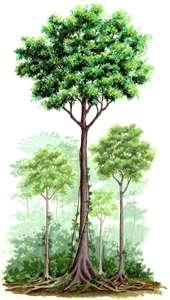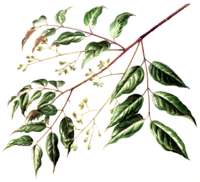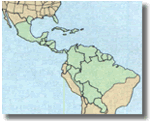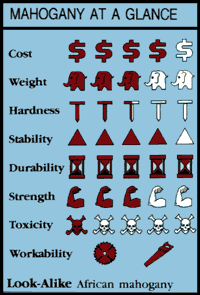The classic choice in tropical timber

The first mahogany to reach England was in the shape of ships—those of the Spanish Armada that later succumbed to the English fleet’s cannonballs. That was in 1588, more than 30 years after the Spanish explorer Hernando Cortes discovered mahogany in the Caribbean.

Although English shipbuilders marveled at the new seagoing stock, it was the joiners who really appreciated this New World treasure. They could span greater lengths and widths than with any other wood available, due to the sheer size of the mahogany timbers.
By the late 1700s, the now- famous English cabinetmakers Chippendale, Hepplewhite, and Sheraton were shaping mahogany into classic furniture styles that kept the wood prominent for 150 years. Today’s woodworker still finds delight in working mahogany into elegant cabinets, desks, tables, and other furniture.
Wood identification

Often referred to in the wood trade as Tropical American mahogany, Honduras mahogany (Swietenia macrophylla) grows throughout much of Central and South America, including southern Mexico. However, the first mahogany discovered by Spanish explorers was Cuban mahogany (Swietenia mahogoni), a species no longer commercially available. Another true mahogany exists in Africa—African mahogany (Khaya ivorensis). Philippine mahogany isn’t a mahogany at all, but rather a Shorea species called lauan.
In the tropical forest, Honduras mahogany sometimes attains 150′ heights and diameters of 72″. Trees planted and grown for lumber on plantations (found in mahogany’s natural range and the South Pacific), run smaller. Honduras mahogany on the stump has a heavily buttressed trunk base, scaly gray bark, and leaves displaying six to eight leaflets arranged on a single stem, much like those of the black walnut tree.
Honduras mahogany wood has straight, semi-open grain and a color that ranges from yellow-brown to dark red, depending on where it grows. With age, though, mahogany of all colors becomes a rich, dark red-brown. The wood also may display exceptional fiddleback, quilt, and ribbon-stripe figure.
A bit lighter than maple at 32 pounds per cubic foot, Honduras mahogany matches oak in strength. The wood also with stands moisture, resists fire and decay, and remains stable in use.
Uses in woodworking
Mahogany claims the qualities that make it the ideal stock for majestic desks, tables, and large cabinets. Both turners and carvers find the wood suited for intricately detailed work. And, today’s boatbuilders, like those centuries ago, turn to Honduras mahogany for structural members, decking, and trim.
AvailabiIity

Due to the tree’s size, Honduras mahogany boards usually run wide and long.
Machining methods
Paul McClure, WOOD® magazine’s consultant on wood technology, calls Honduras mahogany “the wood by which all other woods are measured.” By that, he means you couldn’t ask for a better wood to work. And, all the craftsmen we asked agree with him. So, note our advice, and enjoy this singular stock:
- We don’t know exactly why, but Honduras mahogany produces extremely fine dust during some machining operations. And, the dust hangs in the air longer than that of other woods. So, wear a respirator.
- Because of this mahogany’s hardness and straight grain, it surfaces with minimal tearout. The wood even proves forgiving if you accidentally feed it into the jointer against the grain. Sharp knives leave nearly glass-smooth results free of mill marks. Feed figured stock into a planer slowly and at a slight angle. Otherwise, the wood grain may chip and tear on you.
- You can rip Honduras mahogany equally well with steel or carbide-tipped blades. However, blades with more than 28 teeth increase the chance of burning.
- Don’t take chances on the wood splintering while crosscutting. With a handsaw or power tools, always use a fence or backing board as a chip breaker on the exit side.
- Honduras mahogany cuts beautifully with a jigsaw or scrollsaw.
- Rout this wood with sharp bits (and don’t forget the dust mask) for mark-free results. The grain “frizzes” with dull bits.
- You won’t have problems joining Honduras mahogany, as all types of glue work well.
- Although the wood easily sands smooth, filling its open grain results in the sleekest surface.
- Choose any type of stain or finish for your Honduras mahogany project because the wood accepts them all equally. For outdoor projects, rely on a spar varnish or exterior polyurethane. It also takes and holds paint exceptionally well, but you’ll need a primer coat and several top coats to completely fill the wood’s open grain.
Carving comments
Honduras mahogany became tbe wood for classic furniture because it was great to carve with knives and gouges and took detail. That holds true today. Power carvers should, however, adopt a light touch because motorized bits can get overly aggressive.
Turning tips
- To avoid chipping, round down Honduras mahogany with a gouge at 800-1,000 rpm.
- Turn off the lathe for final sanding, and sand with the grain.
- Don’t apply finish to spinning wood because the open grain of Honduras mahogany momentarily collects the material. Then, as it spins, the finishing material flows from the grain to form what looks like wrinkles.
SHOP-TESTED TECHNIQUES THAT ALWAYS WORK

Any exceptions, and special tips pertaining to this issue’s featured wood species, appear under headings elsewhere on this page.
- For stability in use, always work wood with a maximum moisture content of 8 percent.
- Feed straight-grained wood into planer knives at a 90° angle. To avoid tearing, feed wood with figured or twisted grain at a slight angle (about 15°), and take shallow cuts of about 1/32″.
- For clean cuts, rip with a rip-profile blade that has 24-32 teeth. For crosscutting, use a blade with about 40 teeth.
- Avoid drilling with twist drills. They tend to wander and cause breakout. Use a backing board under the workpiece.
- Drill pilot holes for screws.
- Rout with sharp, preferably carbide-tipped, bits and take shallow passes to avoid burning.
- Carving hardwoods generally means shallow gouge bevels—15° to 20°—and shallow cuts.

